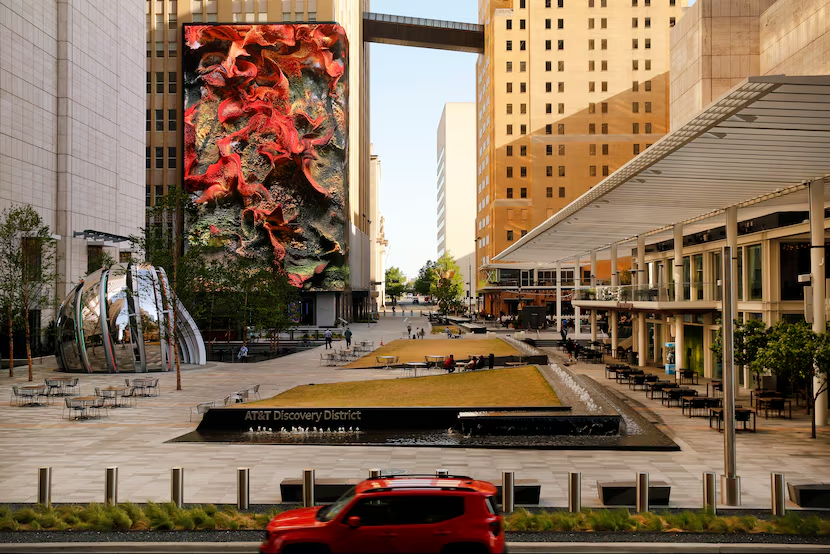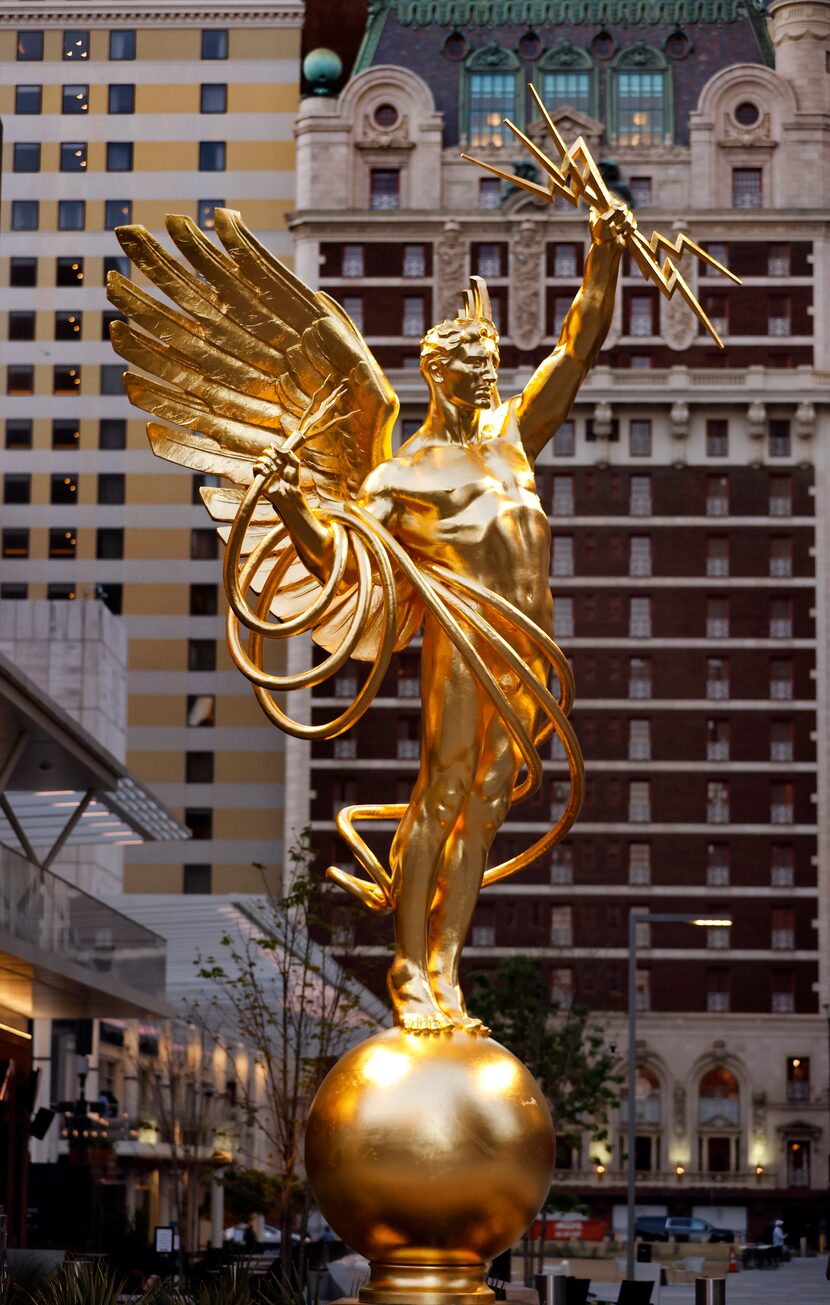The city that rolls up its sidewalks at five o’clock would like to be more like the city that never sleeps. At least a little bit, anyway, judging by the newly (if not officially) opened AT&T Discovery District, which brings a small taste of New York’s Times Square to downtown Dallas. It is, by any measure, progress.
The $100 million project remakes the moribund space around AT&T’s undistinguished collection of downtown buildings into a multiblock, landscaped pedestrian plaza, a genuine urban place in the heart of the city.
The “district,” really more of a plaza, is centered on a pedestrianized stretch of what was Akard Street, running from Commerce to Wood Streets. Among its signature features is a 104-foot-tall video board, or “media wall,” that wraps the corner of one of the four buildings, all owned by AT&T, fronting the plaza.
The singular corporate presence poses a philosophical conundrum: is this a public space or is it a corporate campus? The answer is yes, which is to say both at once. In that melding, it may be the quintessential physical expression of the business-first ethos that has defined Dallas from its very inception.

Dallasites are used to a co-mingling of public space with private enterprise: For decades, the most popular (and best maintained) pedestrian environment in the city has been a mall: NorthPark Center.
“There is no other corporate headquarters in America that’s like this. It’s unprecedented,” says Barry Hand, the principal at Gensler architects who oversaw the project.
That may be hyperbole, but it’s not entirely untrue. While other titans of Big Tech — Apple, Facebook, Google — make dubious claims of digital “transparency,” in the three-dimensional world they have constructed closed-off, highly secured suburban campuses.
In reaffirming its commitment to downtown Dallas, AT&T has done the opposite. That decision is of enormous benefit to the city, especially at a moment when the pandemic has left the future of the office (and downtown real estate) an uncertainty. Even if the company does not bring back all 5,500 of its workers, its continuing presence and investment bring new energy and a sense of economic stability to the urban core.
AT&T’s presence, as you might expect, is both ubiquitous and at times disconcertingly overwhelming, although they would like you to believe otherwise. On a recent visit, Hand described the branding of the site as “subtle.” At the time, we were standing in a 30-foot tall rendition of the company’s globe logo that rotates 180 degrees and lights up like a rainbow. I guess all things are relative?
“The globe is a focal point, a celebration of our brand and our history,” says Erin Scarborough, senior vice president of planning and administration for AT&T. But on the other hand: “It’s meant to be fungible in terms of its interpretation. It’s not literal.”
Fungible or not, as public sculpture it’s about as crass as you can get, though inevitably it has become an Instagram magnet, which was surely the plan: a stream of happy social media posts burnishing the image of a company notorious for poor customer service.

The globe’s placement as a visual attraction toward the Commerce Street front of the plaza is especially unfortunate, as there was a better option: the 24-foot tall Spirit of Communication — better known as “Golden Boy” — the resplendent 1916 sculpture by Evelyn Beatrice Longman that has been a company icon for more than a century, and most recently commanded the lobby of its Dallas headquarters building.
What a dramatic entry the winged hero would have made to the plaza, with its lightning bolts aloft and body wrapped in thick wire: the cable guy as Olympian deity. The architects had the good sense to liberate it from the interior, but it has unfortunately been relegated to the back end of the plaza, along Wood Street.
Structurally, Gensler has done well by not doing too much. The most prominent architectural components of the design are a pair of cantilevering two-story white steel trellises that line the edges of the plaza, providing shade to the spaces below while reinforcing the north-south axis of the plaza. That spine is continued by the handsome pavers of rectangular gray stone, which become progressively darker moving from Commerce toward Wood streets.
Jackson Street has also been shut to traffic (although it can be reopened for emergency vehicles) between Browder and Field. The block of Browder between Commerce and Jackson has likewise been pedestrianized, but treated as something of an afterthought.

But the focus of the district is squarely on its central Akard plaza. Here, cafes and restaurants line the west side, protected from the central spine by a low fountain and a lawn that is already in need of replacement, even before the formal unveiling. Some form of artificial turf seems in the offing here, though a design of more resilient native grasses would have been better.

The opposite side of the plaza is devoted to business. Visitors can enter the lobby of the company’s main Whitacre Tower building — enveloped in swishy high definition video screens — and access a public gallery. (Currently showing are images from the “Snyder Cut” of the superhero film Justice League, courtesy of AT&T subsidiary Warner Bros.).
Outside, adjacent to the fungible globe, is a sunken “collaboration grove,” with both individual and communal tables. It is an eminently pleasant place to sit, and there is free WiFi throughout the plaza — powered by recycled wind energy — for those who wish to work. Although not always pleasant. Too often, overly loud pop music is pumped into the plaza from a powerful sound system. I’m not sure whether the blame here falls on a desire to add a form of sonic branding or a misguided sense that without it the plaza might feel less alive. Either way, it is a detriment.
The sound, often but not always, accompanies images on the titanic video board, which covers nearly 10 stories of the historic building on the southeast corner of Akard and Jackson. That building protrudes into the axis of the plaza, creating a view corridor such that the video board is visible from across downtown. This is the plaza’s Times Square moment, and it is impressive, especially at night.

But it is also awkward. The board covers a grid of windows, creating the impression of office spaces stuck behind the enormous monitor. (According to AT&T those spaces are used for mechanical equipment.) Meanwhile, the almost entirely blank, windowless wall of the Whitacre tower is left alone, facing the plaza. Architecturally, losing the vista would have been a reasonable price for a more coherent design.
Pondering what might have been is a venerable Dallas tradition, and this plaza is as good a place to do it as any. Surely the greatest architectural pleasure here, and it alone is worth the trip, is the glorious axial view of the Adolphus Hotel, grande dame of the Dallas skyline, and its distinguished neighbor, the beaux-arts Magnolia Hotel.
Close your eyes here, and it is easy to fall back into the past, when a line of bars ran along the west side of Akard facing the handsome Baker Hotel, demolished to make way for the Whitacre Tower. In November of 1960, the space that is now the “collaboration grove” was overrun by right-wing firebrand Bruce Alger and his “Mink Coat Mob” of well-heeled North Dallas women, there to protest — in most vulgar fashion — Lyndon and Lady Bird Johnson, when Johnson was the Democratic nominee for vice president.

That spirit of protest lives on today in that same space, although thankfully in a more peaceful form. On a recent visit, members of the Next Generation Action Network had set up in the plaza, there to urge AT&T to take a strong stand against restrictive voting rights legislation in Texas.
This was a significant test for the plaza, and a potentially defining one. Would security push the group out, or would they be allowed to have their say? To what extent would free speech be allowed in what is putatively a public space.
The group stayed, and without incident.


